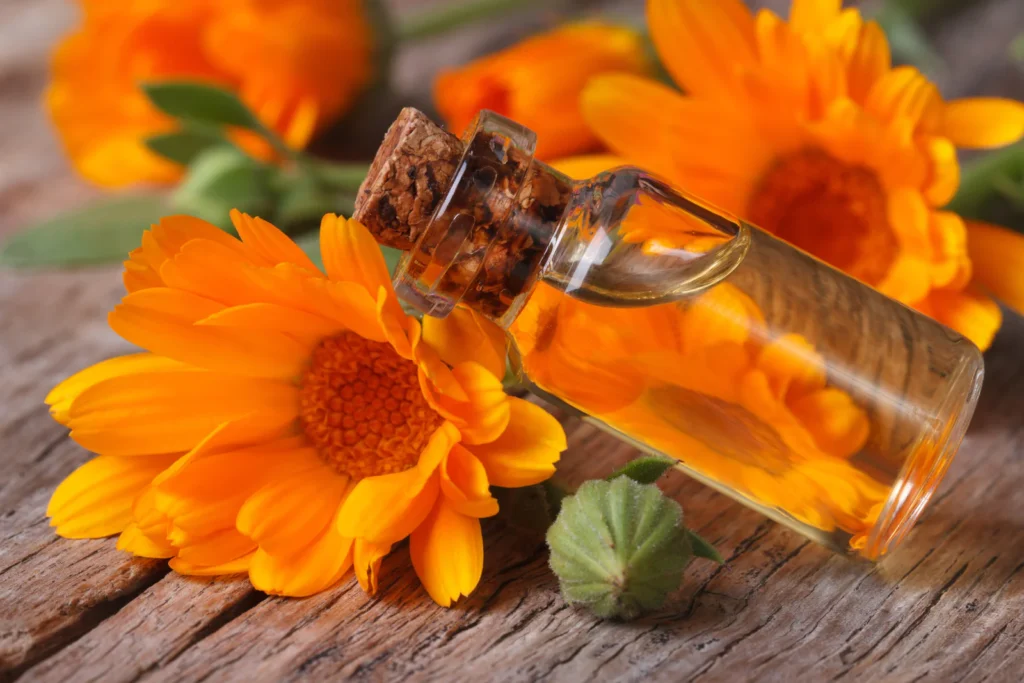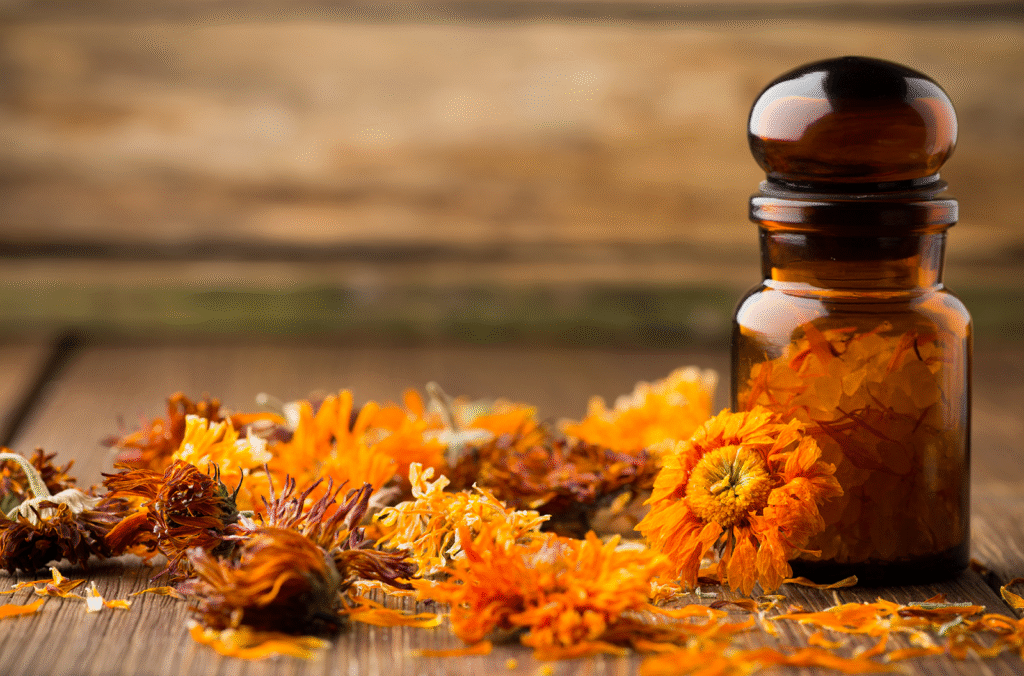
🌼 Calendula: 30 Incredible Benefits & Everyday Uses
Nature’s Brightest Healing Flower You’ll Wish You Discovered Sooner
Calendula, often referred to as “pot marigold”, isn’t just another pretty flower in the garden. Behind those vibrant orange and yellow blooms lies a powerhouse of healing, culinary, skincare, and wellness benefits that have been trusted for centuries.
From soothing irritated skin and treating minor cuts to brightening up dishes and warding off garden pests, calendula is a true multi-tasker. And the best part? It’s easy to grow, gentle enough for babies, and incredibly versatile in your DIY herbal toolkit.

Let’s dive into 30 amazing ways you can use calendula in your home, garden, kitchen, and skincare routine—and why you should always have some on hand.
🌿 What Is Calendula, Really?
Calendula (Calendula officinalis) is an annual herb in the daisy family, native to the Mediterranean. Don’t confuse it with French or African marigolds (Tagetes)—calendula is its own herbal superstar, known for its anti-inflammatory, antimicrobial, and antifungal properties.
It’s been used for thousands of years in herbal medicine and still holds its place today in salves, teas, oils, and more. Whether you grow it yourself or buy it dried or fresh, calendula is a must-have in any natural wellness arsenal.
🧡 30 Amazing Calendula Benefits & Uses (Broken Down by Category)
Let’s break it down into categories so you can easily find what you’re looking for.
🌱 1–10: Skincare & Beauty Uses
Calendula is incredibly gentle yet powerful when it comes to healing and soothing the skin.
- Soothes dry or cracked skin – Calendula oil or balm provides moisture and promotes healing.
- Fights acne – Its antibacterial properties help calm inflammation and reduce breakouts.
- Reduces eczema and dermatitis – Great for flare-ups thanks to its anti-inflammatory compounds.
- Speeds up wound healing – Use in salves for scrapes, burns, and minor cuts.
- Helps with diaper rash – Safe for babies; calendula cream soothes tender baby bottoms.
- Fights fungal infections – Use calendula-infused oil for athlete’s foot or yeast imbalances.
- Soothes razor burn – Calendula toners or balms calm irritated skin after shaving.
- Softens lips – Calendula lip balm is nourishing, especially in dry seasons.
- Reduces sunburn redness – Apply as an after-sun lotion to relieve pain and redness.
- Tames inflamed cuticles – Add to nail oil blends for gentle repair.
🌼 11–20: Healing & Health Uses

Calendula isn’t just skin-deep—it offers internal and external healing benefits as well.
- Supports wound care – Calendula salves reduce infection risk and inflammation.
- Promotes oral health – Calendula mouthwash or gargle can ease gum irritation and mouth ulcers.
- Helps with sore throats – Gargling cooled calendula tea brings natural relief.
- Assists in menstrual regulation – Drinking calendula tea may help balance menstrual cycles.
- Reduces swelling – Calendula compresses can soothe sprains or swollen joints.
- Soothes insect bites and stings – Anti-itch and anti-inflammatory when applied as a balm.
- Calms pink eye – Diluted calendula wash can ease mild eye inflammation.
- Cleans minor infections – Infused water or oil helps keep wounds clean naturally.
- May support immune response – Some studies suggest calendula has immune-boosting effects.
- Relieves hemorrhoid symptoms – Use calendula ointments for soothing relief.
🍵 21–25: Culinary & Edible Uses
Calendula flowers aren’t just medicinal—they’re also edible and flavorful!
- Sprinkle petals on salads – Adds color and a mild peppery flavor.
- Infuse in teas – Great for digestion, inflammation, or relaxation.
- Use as a saffron substitute – Dried petals can mimic saffron’s golden hue in rice or soup.
- Make calendula honey – Infuse dried petals into raw honey for herbal sweetener.
- Decorate baked goods – Fresh or dried petals look beautiful on cakes and muffins.
✨ Pro tip: Only use organically grown, untreated calendula for culinary purposes.
🌸 26–30: Household, Garden & DIY Uses
Calendula is a gardener’s best friend and a DIY dream.
- Natural dye – Calendula petals can color fabric, soap, or beauty products.
- Pollinator magnet – Bees and butterflies love calendula, helping boost your garden’s health.
- Deters pests – Calendula helps repel aphids, whiteflies, and root nematodes.
- DIY soap ingredient – Infuse into oils or add dried petals to your homemade bars.
- Make your own salves, balms & oils – Calendula is easy to dry and infuse for herbal first-aid kits.
🌞 How to Use Calendula at Home

🌼 Calendula Infused Oil
- Fill a jar with dried petals.
- Cover with olive oil or sunflower oil.
- Let it sit in a sunny window for 2–4 weeks.
- Strain and use in skincare, salves, or lotions.
🌼 Calendula Tea
- Steep 1 tsp dried petals in 1 cup hot water for 10–15 minutes.
- Strain and sip, or cool and use as a facial rinse or wound wash.
🌼 Calendula Salve
- Melt calendula-infused oil with beeswax.
- Add optional extras like lavender or tea tree oil.
- Pour into tins and let it set.
Table of Contents
❓ Frequently Asked Questions
Q: Is calendula the same as regular marigold?
Nope! Although they look similar, calendula (Calendula officinalis) and marigold (Tagetes) are different species. Calendula is edible and medicinal—Tagetes is not.
Q: Can you use calendula on sensitive skin?
Yes! Calendula is incredibly gentle and safe for babies, pets, and those with eczema or sensitive skin.
Q: Can I grow calendula at home?
Absolutely. Calendula is one of the easiest flowers to grow. It prefers full sun, cool weather, and blooms generously with minimal care.
Q: How do I dry calendula flowers?
- Pick when fully open and dry on a screen or tray in a shaded, well-ventilated space.
- Store in airtight jars out of direct light.
Q: How long does calendula-infused oil last?
If stored in a cool, dark place, it should last up to 1 year. Adding vitamin E can extend shelf life slightly.
✅ Final Thoughts: Why Calendula Deserves a Spot in Every Home
Calendula is more than just a pretty face. It’s a powerful herbal ally with a wide range of healing, cosmetic, culinary, and garden uses. Whether you’re sipping it in a tea, slathering on a salve, decorating a dish, or soothing your skin, calendula brings beauty and purpose to nearly every part of your life.
It’s gentle enough for daily use, yet potent enough to handle real issues—from bug bites to baby rashes to acne to stubborn inflammation. The best part? It’s incredibly easy to grow, harvest, and preserve at home.
Once you begin working with calendula, you’ll wonder how you ever lived without it. 🌼
🧾 Quick Calendula Benefits Recap
| Category | Use Case |
|---|---|
| Skincare | Acne, eczema, sunburn, cracked skin, diaper rash |
| Health & Healing | Oral health, sore throat, menstrual support, bug bites |
| Culinary | Tea, salad garnish, saffron substitute, edible décor |
| Household & Garden | Natural dye, pollinator plant, pest control, homemade soap |
| DIY Essentials | Salves, lip balms, oils, lotions, herbal baths |
